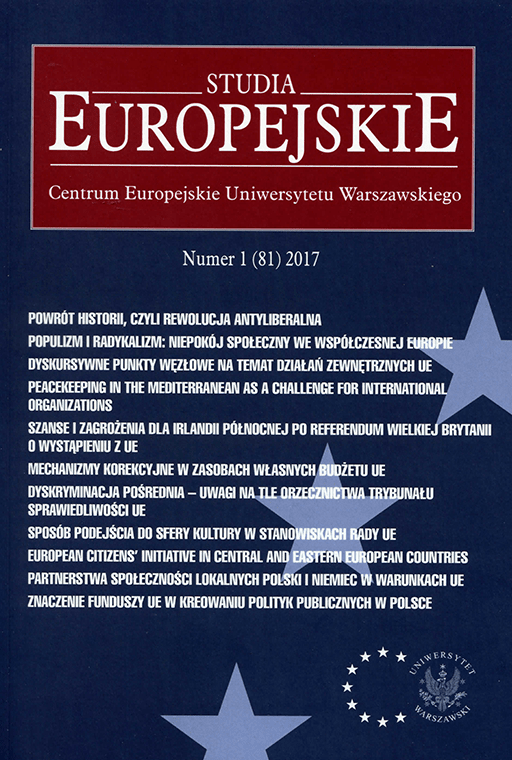
ISSUE: 1/2017
- Volume 81
- Number 1
- 2017
Subscribe NEWSLETTER
Studia Europejskie –
Studies in European Affairs
ISSN: 1428-149X
e-ISSN: 2719-3780
License
Articles published in the journal are under a Creative Commons Attribution – Non Commercial – No Derivatives 4.0 International License
Obiektywne uzasadnienie jako istotny element dyskryminacji pośredniej – uwagi na tle orzecznictwa Trybunału Sprawiedliwości UE
Objective Justification as an Important Element of Indirect Discrimination – Refl ections on the Basis of the Case-Law of the Court of Justice
Abstract
The article concentrates on the case-law of the Court of Justice concerning indirect discrimination, in particular one of its elements called objective justifi cation. It should be noticed that this form of discrimination refers to neutral criteria which are not forbidden as such but their application puts the group of persons protected in a disadvantageous position. Such indirectly discriminatory measures can be justified by a legitimate aim but the means used to achieve it should be appropriate and necessary.These legitimate aims cannot be connected with any discrimination based on the forbidden criterion e.g. nationality, sex, age, disability etc. According to the case-law of the Court of Justice their list is not closed. However, legitimate aims can be divided into three groups: those that are related to the public interest and those that refer to the job or the company as a whole. It is interesting to note that the Court of Justice allows employers or service providers to refer to economic factors which is criticised by the doctrine of European Law. It is suggested that it should limit the list of aims which may justify indirect discrimination. Wide discretion in this regard may lead to weakening of the effectiveness of the prohibition of indirect discrimination. Another important element of this form of discrimination is proportionality of the measures applied to achieve a legitimate aim. The Court of Justice has not always applied the same proportionality test in relation to the measures undertaken by the Member States and by employers or service providers. However, the Court has changed its approach recently and has started to assess the proportionality of the measure in a similar way. On the whole it should be underlined that the Court of Justice plays a decisive role in the practical application of indirect discrimination. It can contribute to strengthening of the effectiveness of its prohibition e.g. by taking into account proportionality sensu stricto in the frames of objective justifi cation and investigating whether there is an excessive restriction of individual rights in relation to the legitimate aim.
References
Asscher-Vonk I.P., Towards One Concept of Objective Justifi cation? w: Non-Discrimination Law: Comparative Perspectives, red. T. Loenen, P.R. Rodrigues, Hague–London–Boston 1999.
Bernard N., What Are the Purposes of EC Discrimination Law? w: Discrimination Law: Concepts, Limitations and Justifi cations, red. J. Dine, B. Watt, London 1996.
Brealey M., Hoskins M., Remedies in EC Law, London 1998.
Czapliński W., Zasada równouprawnienia płci w orzecznictwie Europejskiego Trybunału Sprawiedliwości, w: Wokół problemów zawodowego równouprawnienia kobiet i mężczyzn, red. R. Siemieńska, Warszawa 1997.
De Búrca G., The Principle of Proportionality and its Application in EC Law, “Yearbook of European Law”, t. 13/1993.
Ellis E., EC Sex Equality Law, Oxford 1998.
Ellis E., Gender Discrimination Law in the European Community, w: Discrimination Law: Concepts, Limitations and Justifi cations, red. J. Dine, B. Watt, London 1996.
Ellis E., The Concept of Proportionality in European Community Sex Discrimination Law, w: The Principle of Proportionality in the Laws of Europe, red. E. Ellis, Oxford 1999.
Hervey T.K., Justifi cations for Sex Discrimination in Employment, London–Dublin–Edinburgh–Brussels 1993.
Jacobs F.G., Recent Developments in the Principle of Proportionality in European Community Law, w: The Principle of Proportionality in the Laws of Europe, red. E. Ellis, Oxford 1999.
Leader S., Proportionality and the Justification of Discrimination, w: Discrimination Law: Concepts, Limitations and Justifi cations, red. J. Dine, B. Watt, London 1996.
Maliszewska-Nienartowicz J., Dyskryminacja pośrednia w prawie Unii Europejskiej, Toruń 2012.
More G., Equality of Treatment in EC Law: the Limits of Market Equality, w: Feminist Perspectives on the Foundational Subjects of Law, red. A. Bottomley, London 1996.
O’Leary S., Employment Law at the European Court of Justice. Judicial Structures, Policies and Processes, Oxford 2002.
O’Neill A., Decisions of the European Court of Justice and Their Constitutional Implications, London–Dublin–Edinburgh 1994.
Schiek D., Indirect Discrimination, w: Cases, Materials and Text on National, Supranational and International Non-Discrimination Law, red. D. Schiek, L. Waddington, M. Bell, Oxford 2007.
Tobler Ch., Indirect Discrimination: A Case Study into the Development of the Legal Concept of Indirect Discrimination under EC Law, Antwerpia-Oxford 2005.
Tobler Ch., Limits and Potential of the Concept of Indirect Discrimination, European Commission. Directorate-General for Employment, Social Affairs and Equal Opportunities Unit G2, Offi ce for Offi cial Publications of the European Communities, Luxembourg 2008.
Tridimas T., The Principle of Proportionality in Community Law: from the Rule of Law to Market Integration, “The Irish Jurist”, t. 31/1996.
Wandzel M., Czy można usprawiedliwić dyskryminację pośrednią? Sposoby weryfikacji zarzutu dyskryminacji pośredniej w orzecznictwie Europejskiego Trybunału Sprawiedliwości w Luksemburgu, „Studia z Zakresu Prawa Pracy” 2001/2002.
Wandzel M., Nowy kształt kontratypów dyskryminacji po nowelizacji Kodeksu pracy, „Monitor Prawa Pracy”, nr 5/2009.
Language: Polish
Pages: 137-157
How to Cite:
Harvard
Maliszewska-Nienartowicz, J. (2017) "Obiektywne uzasadnienie jako istotny element dyskryminacji pośredniej – uwagi na tle orzecznictwa Trybunału Sprawiedliwości UE". Studia Europejskie – Studies in European Affairs, 1/2017, pp. 137-157.